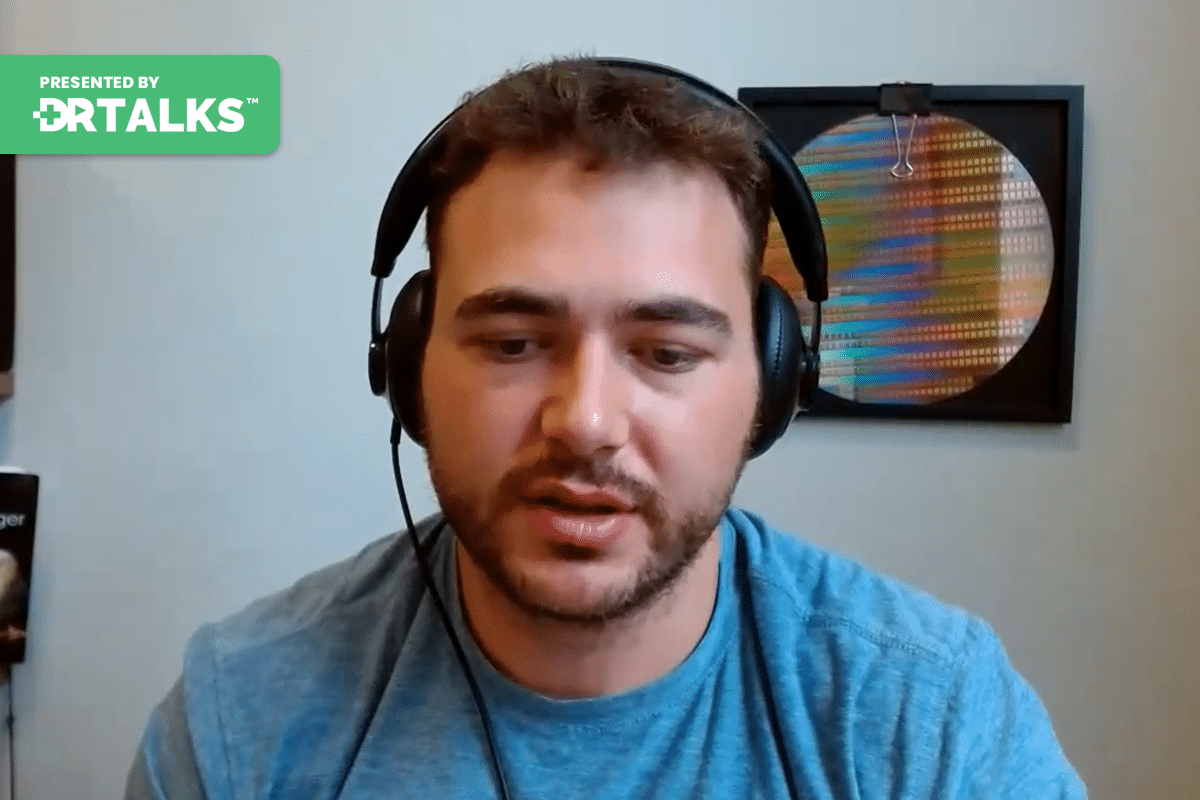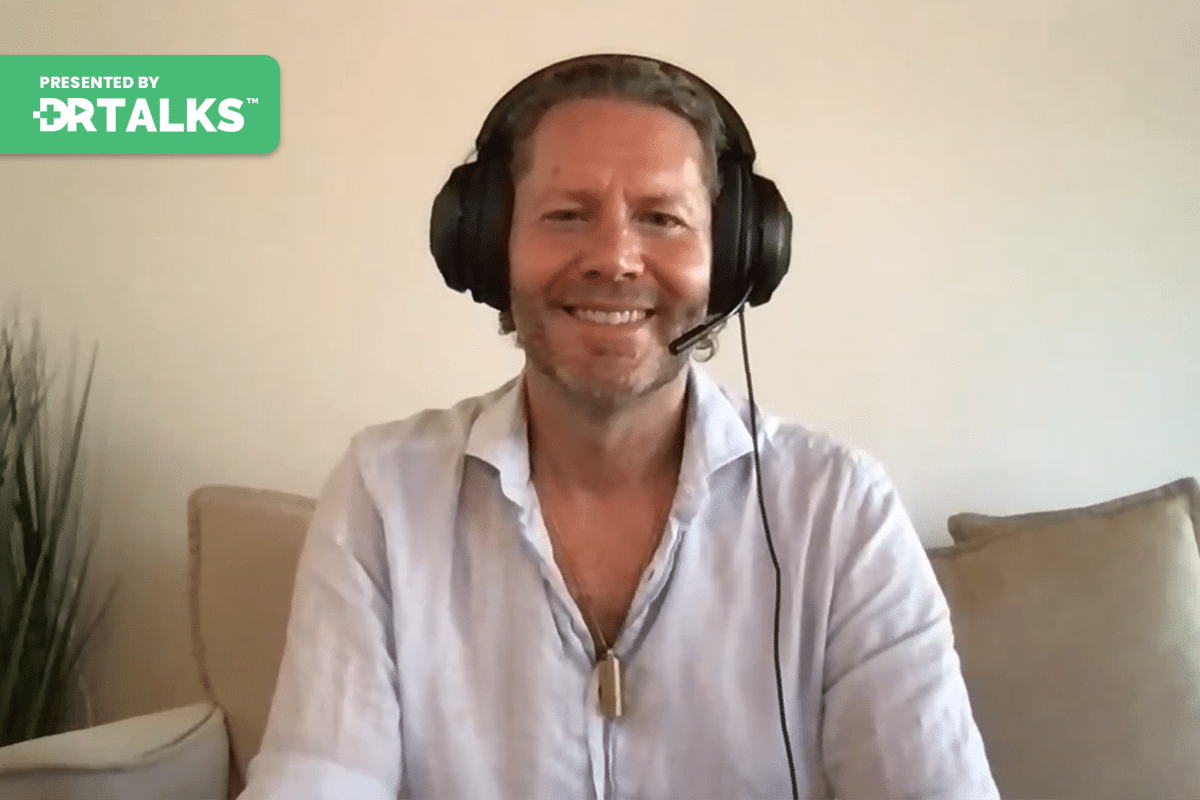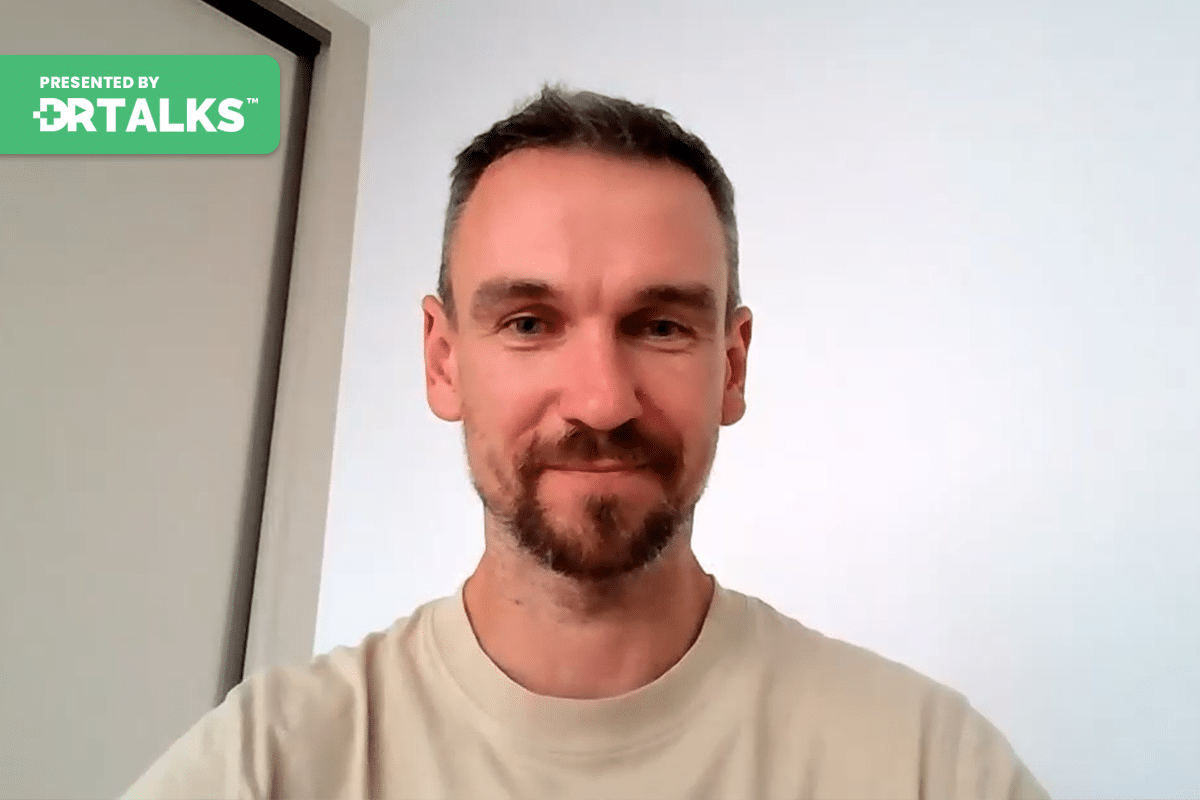Join the discussion below

Kashif Khan is the Chief Executive Officer and Founder of The DNA Company, where personalized medicine is being pioneered through unique insights into the human genome. With the largest study of its kind globally, The DNA Company has developed a functional approach to genomic interpretation overlaying environment, nutrition, and lifestyle... Read More

Dr. Ruan is the Founder and CEO of Texas Center for Lifestyle Medicine. He devotes his career in practicing and building systems that allow for efficient delivery of healthcare. He is a board certified internal medicine physician but also have advised with companies to improve their workflow, company culture, marketing,... Read More
- Discover the transformative power of breathing and how it remarkably impacts your brain function and cognitive abilities
- Understand the critical connection between skull and dental health and brain function, and take steps to ensure your overall health
- Use breathwork as a potent tool to reverse chronic diseases and unlock hereditary patterns that hinder your health journey
Related Topics
Adhd, Autoimmune Disease, Bowel Movements, Brain, Breath, Cellular Respiration, Chinese Medicine, Chronic Disease States, Chronic Illnesses, Cortisol, Detoxification, Eastern Medicine, Fibromyalgia, Filtration, Gastroparesis, Gi Tract, Malabsorption, Mental Health Issues, Nasal Breathing, Nitric Oxide, Palate, Peripheral Neuropathy, Sinuses, Skull-brain Connection, Sleep Apnea, Soft Tissues, Stem Cells, TeethKashif Khan
All right, everybody, welcome back. I would say a few months ago, I was invited to participate in this summit and it blew me away because who’s joining us here today, Dr. Cheng Ruan, curated I would say 40 maybe 50 speakers to talk about reversing brain disorders. And it was really awesome because you heard from all these different perspectives. Why what we think is coming doesn’t have to come. You know, how we could actually heal the brain and reverse what we think is ancestral or in our DNA, for example? It was really cool. So, first of all, thank you for joining us.
Cheng Ruan, MD
Thank you.
Kashif Khan
Appreciate it. The knowledge and you know, we had a chat after that with your audience and you were dropping knowledge bombs like, wow, this guy knows things that I haven’t heard before. And it was really cool. So we’re happy to have you share that with us today. And even, you know, when we discuss like, hey, where do you think we should go? Because there’s so much, you know, you started with something that even that was like a mic drop. Let’s talk about the skull brain connection and we’re going to talk about breathing and how breathing is going to work. What are you talking about when you think exercise in the skull brain could actually, I never heard this stuff. So anyways thank you for again for joining. So what do you even mean by the skull-brain connection?
Cheng Ruan, MD
Yeah. So most people will just, you know, think of the brain as sort of a compartmentalized organ, right? And that this is the organ just kind of conducts and does stuff but there’s a whole lot more to it. And this is really rooted in Eastern medicine, Chinese medicine, and even before that to even the Egyptians and understanding of what’s needed to support this through this brain function. So let’s talk about that. So we think about the brain as an organ. What does it do? It thinks, it conducts our body, right? It feels and without the brain, obviously, we can’t live. But most importantly, like what, what creates sort of this brain function? How do you sort of optimizes brain function? And so a majority of the optimization of brain function is where the brain actually sits in, which is the skull, right. So you have the brain here and then covering the brain, you have this thing called dura mater, which is called tough mother, right? Which kind of protects it. And then below that you have vessels, you have lymphatic channels and stuff like that, right. That helps the detoxification process of the brain. Well, all that stuff is actually anchored into your skull. And so your skull is not optimized for the functional, physical functionality of the brain, then it’s not going to do so well. And now in this generation, there’s a lot of people with impaired skull function. And so what are the components of the skull that really affect the brain? Well, within the skull itself you have the actual skull structure, you have bones that are right here. Right.
And then within the bones of these case that are called sinuses, which are extraordinarily important, extraordinarily important to brain function. Then just below that, you have your palate and then you have your teeth, and then you have the soft tissues of the face and of the head. And these soft tissues are also extraordinarily important for the functionality of the brain as well. And the entire skull is a collection of all chemical and physical processes. The biochemical process is the chemical signaling that gets created. And there’s a physical process which is really to receive air, right? And so you breathe through your nose. It goes to the skull, to your mouth. It goes to the skull. Right. It’s that filtration really occurs first in that a majority of the filtration actually occurs when the air goes into the nose, into the sinuses. There’s things that are filter gunk, if you will, or toxins or bacteria or viruses, whatever it may be.
And that entire system talks to the rest of the body. So if there’s something within your sinuses, your body, nose, your hands, you get chronically cold, right. You can have some nerve issues. And the more distally, your feet and stuff like that. And because of this mechanism that tells the body to sequester whatever is going on here, put all the troops towards sequestering this thing. Right. And that sequestration actually takes away the actual ability for the brain to function properly. So in a nutshell, that’s sort of where the skull brain connection is related.
Kashif Khan
Interesting. That’s where, so nose breathing versus mouth breathing. There’s a lot you’re hearing even in the biohacking community. People are mouth taping their mouths shut to go to sleep at night. All the benefits of using this system versus this which was not designed for breathing. So even that one thing could potentially change somebody’s health outcome.
Cheng Ruan, MD
Yeah. So mouth taping going on forever, for thousands of years, you know. In fact, in Eastern Medicine, that’s one of the treatments for pediatric seizure disorder is you make them breathe in as infants to prevent fits or seizures. Right. And so the philosophy behind this is that whenever you cover someone’s mouth, you have to force that nasal breathing air goes into the nose. It goes past different structures, different hairs in the nose, it goes into the sinuses. And there’s receptors in there that receive. And these receptors are able to get the body’s own cells in the blood vessels come into being able to produce something called nitric oxide. And nitric oxide is the modern terminology for ancient descriptions of chi or mana or prana, depending on what, what culture you’re from. Right, the flow of the flow of energetics. And so nitric oxide allows the delivery of blood flow and nutrients and lymphatics to different parts of the body. This is why nasal breathing has been so powerful to optimize these things. And a lack of breath or lack of nasal breathing tend to be the culprit behind majority of the chronic disease states, whether it’s autoimmune disease, mental health issues, ADHD being the most common one of sleep apnea and so on and so forth and so that system is not very robust when you breathe through the mouth, when you breathe through the mouth, become chronic mouth breather.
So if you look at all ancient texts and ancient medicines, mouth breathing has been shown to keep people in this unbalanced state, which we now call this the perpetual sympathetic states of the autonomic nervous system, the fight or flight. And go, go, go, go, go. So, if you do that, and there’s nothing wrong with being that state temporarily but being in that state all the time you age significantly faster. You don’t sleep as well. You don’t have enough stem cells to support your regeneration patterns and therefore the aging starts to accelerate. This is where we see like brain shrinking in the elderly. This is where we start to see blood vessels being calcified or calcified blood vessels deal. Right. So it really starts with the breath process. And right now, especially in my field, which is functional health, there’s a huge focus on like food as medicine, food as medicine, foods, medicine all say, well, food is only medicine if your breath is optimized first. So, you know, air before food, not always.
Kashif Khan
So you can actually alter your call pool or library of stem cells based on how you breathe.
Cheng Ruan, MD
Oh, yes. So this is this is, it’s not surprising because let’s talk about this so that the stem cells that are these cells that are have the ability to regenerate or they have the ability to tell the other cells around them to regenerate. Okay. Right. And so what is controlling the activation of these stem cells or as it turns out, what it all cells mean, all cells in the fundamental process requires oxygen, carbon dioxide, exchange rate, cellular respiration. It requires other different biochemical processes which the root mechanism for that is nitric oxide and production, something called nitric oxide simplex and OS and OS is that that triggering mechanism is is triggered by action nasal breathing in nitric oxide.
And so we’re talking about a root mechanism here. Right. And so the other things that stem cells really need to do is thing and differentiated needs nutrients. It needs something like and it needs stuff like other B vitamins and stuff like that as well. Right. Well, how do you how do you get nutrients for your body? Can you compose nutrients or you get it from food? Okay. So we get it from through food. You then then your gut, your GI tract has the intact for you to absorb the food, right? Yeah. So how do you know the gut or the GI tract is intact? Well, first bowel movements as that are regulated will show you that the bowels intact. But what about those people suffer from a lot of chronic bowel issues like small intestine back through overgrowth of product bloating, constipation or diarrhea? Well, most people assume is that because they don’t have the best diet, and I don’t think that’s necessarily true, maybe because they don’t have the best breath mechanisms. And so if we look at population health data, right, we know that those people who suffer from a lot of chronic illnesses have other correlating illnesses that are around it. So autoimmune disease, fibromyalgia, you know, Gastroparesis, interest, malabsorption, peripheral neuropathy, these are sort of like the hallmark of these different wrap around disease states and disorders. But they all have one common thing is that you don’t have the ability for the breath to regulate these systems is not going to be there’s not going to be regulated. So when you breathe correctly, your gut is literally able to function much better because there’s also an airway dependent mechanism. So how do you do that? Well, breathing through the nose will allow the common sensation to really occur. So cortisol comes down and then you have different internal peptides that gets released by the organs and by the gut itself, and it allows for much better function of the gut.
So not surprisingly, impaired airway syndrome which sleep disorder, breathing or or any similar mechanisms such as obstructive sleep apnea, chronic sinus issues and histamine issues always involves the gut. But I think there’s a hyperfocus on all disease states start in the gut. Well, your gut starts here. This is the beginning right here. This is your mouth. This is the beginning of your GI tract. Right. And so you’re microorganisms within your sinuses as well as within your mouth. Is, is the GI tract. So that is also airway dependent. And so all of these mechanisms are kind of linked to this ability to breathe correctly. And over time, I think society well, we have really created a society of the inability to breathe and that has inherited to multiple generations and call epigenetic inheritance. Right. Multiple generations of mouth readers. And that actually comes from structural changes of the skull, the face, the mouth and the soft tissue changes over generations as well.
Kashif Khan
And speaking of structural structural changes, I’ve heard that, you know, somebody that makes adjustments for you know, there’s there’s inheritance, epigenetics or even genetic inheritance, but within your own lifetime, you can create structural changes by the way you breathe like you might somebody like yourself can probably look at somebody and say, hey, that’s about either, you know, based on their jawline, etc..
Cheng Ruan, MD
So I’m a lifetime mouth breather. And so I’ll show you as my example. So I’m sorry for the people who are listening just on audio, but you’re on video. You’re looking at me. I mean, we actually look at my facial structure. There’s the one very pronounced thing about my sitting straight, my face appear more round. And that’s just because these sides of my face kind of jut out a little bit. Okay. And these muscles are called master muscles. So what do they do? They master key, which means that they chew. So these master muscles have been trained by my brain to contract all the time since I was a baby, to allow me to use my teeth as a fulcrum, right to pop pop out my, my, my TMJ and pursuit of forward to allow the airways come in so the master muscles, the first muscle does that second muscle is this thing right here from my sternum all the way to what’s called the massive process of the skull. And this is called a sternal plateau mastoid. Right? So this muscle right here also contracts over time, along with scaling ins and few other muscles to pull literally my jaw forward so I can get air at nighttime. That allows mouth breathing because I was born with obstructive sleep apnea. So if you look at my profile of my body, the mix right here is a tendency, if you look at the profile of my body, you’ll see that my neck is actually tilted forward quite a bit. Okay. I call it the Donald Trump look. Right? The neck is still to forward. Right. And then the jaw is kind of retracted back. And so my body’s been compensating for mouth breathing. And so that’s why I’ve had a lifetime. His entire history of TMJ issues grinding with what’s called bruxism clenching, all of these are actually mechanisms that keep me alive since I was a little baby, even into adulthood.
Right. And so the necessity for mouth breathing is because my palate was actually formed very narrow, just like the rest of my family. And because of a narrow palate, the entire arch of my superior palate is actually quite high. So it’s really hard for my tongue to fully occlude the top of my Pell in a why would I want my tongue to include top of my palate? Because that’s literally the only way you can fully nasal breathe is if you close your mouth right now, put your tongue to the top of your parents, a deep breath. That’s the only way you can really fully nasal breathe. Right? So because of that, my brain knows I can’t fully nasal breeze. So creates mechanisms and structures and even creates pain to allow me to to all breathe.
A really good example of someone like this is someone who diagnosed with fibromyalgia. So fibromyalgia is a chronic pain syndrome. There’s a lot of head and neck and shoulder pain, hip pain, thighs all the way to the toes. And all of that pain is actually starts right here with the teeth, with the mouth, with the alignment. Right. And it creates sort of this constant like vise like structure, vice-like grip up in the head and neck area to kind of pull the entire body specially upwards. And it makes a really off-kilter. And this is where this concept of like fibromyalgia really comes from, because there is a skull-based approach to improving that as well. And so over time, then you can actually practice breath mechanisms that allow improvement of all these different things. But if you’re someone like me who have major obstruction, severe, severe obstruction, it requires some medical intervention.
You know, sometimes a surgical intervention as well, because I’m born with a skull that I’m born with. Right. And it was underdeveloped over time. And the last part about that is that so I was a very large C-section baby. And there’s nothing wrong with C-section. What I’m saying there is, because I was born in China at a time where because of this concept that I was C-section, there was a lot of things. Traditionally, in culture, you kind of have to take care of the baby. And part of it is a delayed exposure to solid food. So my exposure to solid food didn’t come till like way after year old. Right. And that’s sort of a norm thing when you want to take care of babies now. And part of that means that I wasn’t able to challenge my stem cells to widen when I was a little kid. Right. And so if you think about that in the Western philosophy, well, that’s pretty normal in the Western culture. You know, you have Gerber all the Gerber bottles right here are very soft food. And then there’s this thing called a quote-unquote, choking hazard that’s got all parents fearing the challenge of solid food into a younger palate. So that stems so creation of a one palate doesn’t really occur as a child either. Right. And so these kids tend to end up having overcrowded teeth, overlapping teeth. They ended up having to have multiple teeth removed. By the time they’re teenagers, sometimes they have periodontal disease, sometimes they have gum line recession issues. And that actually comes from the inability to regulate your microbiome. Once again, your microbiome starts in your mouth. Right. And so a lot of these kids tend to have a lot of issues, you know, colicky gut and stuff like that. Right. And into adulthood that later becomes more neurodegenerative things later on in life. And so that’s the concern here. And that’s the thing to really understand for people.
Kashif Khan
So for the person who’s sitting here listening say, Oh, wow, I’m never opening my mouth again.
Cheng Ruan, MD
You know.
Kashif Khan
Where do they start in terms of are there exercises or things they can do to call it breathwork exercises to practice that are maybe beneficial?
Cheng Ruan, MD
Oh, my God. Yeah, absolutely. So it’s not just about breathwork itself, right? It’s actually about breathwork and movements. And so there’s different methods. And the ones that are more familiar with with was more Chinese bass like Taichi and she there’s different breathwork that actually are designed to activate sort of the chief flow of the body. Not surprisingly, they also activate nitric oxide, right? So the blood pressure can start balancing blood sugar can start balancing pain, can start going away. And so being involved in just moving just 30 minutes a day, just moving anything 30 minutes a day can actually improve this over time. Another aspect. So right now, I think what’s really popular, especially since documentaries and Joe Rogan and stuff like that is like women. All right.
And so women health is just one of the many, many different types of breathwork. But a lot of people like to start with women of I don’t recommend it. People aren’t ready for it. You got to start with the basics first. Right? And so my medical practice is Texas Center for Lifestyle Medicine is txlifemed.org. We actually have even online courses. There’s one called online school master workshop. We actually take people through thought processes and breathwork and put in intention that’s created by by a good friend of mine, one of our staff members, Jenny Marino. And so that’ll really take the basics. You gets into the basics and most people are it’ll take a year to really master the basics as well. And so but what’s great about it is when you learn it, you learn it, you know, you’re not buying really expensive supplements or dietary regimens and stuff like that. You know, it’s really designed it to be accessible to everyone, but it really starts with the actual breath work. And then another resources. Another resource is the book Breath by James Nestor. It’s a bright yellow book always on Amazon. That’s an amazing book that talks about the entire history of how we became mouth breathers over time. It’s the book is called Breath The New Science to a Lost Art. And actually, at the end of the chapter, there’s actually guided breath works of you have the audio version. It’s kind of fun to listen to and listen to the breath work at the end of the chapter as well.
Kashif Khan
You know, you mentioned nitric oxide so much and it makes me think about and maybe this is a project that I have to work on with you. The NOS3 gene determines your relationship with Nitric oxide, right? And we find when we’re going through people’s data, most people are not optimal. They’re some are, right. But most people are either heterozygous, like not doing so well or even, you know, fully. Both parents getting the bad copy of this. There’s certain snip that we look at. Yeah. Means it’s not only they’re combating bad breathing or whatever other things going on, but innately they don’t efficiently deal with nitric oxide well. So what do you see? Variable outcome? And perhaps there’s a genetic component there because we see it with the NOS3 gene.
Cheng Ruan, MD
Yeah. So and you know we talked about this before like your genes don’t really define you, right? So, even if you have something like this doesn’t mean all hope is lost, just means you’ve got to work harder in things like breathwork. Right. And these discrepancies may be at an evolutionary advantage that we just don’t know about yet. You know, and from what we know right now, it seems like a evolutionary disadvantage, but we just don’t know. And also, you know, it’s and if you look at a whole sequence of genes, if you combine the ability to to utilize since they utilize the ability to have a good relationship with nitric oxide. Right. And then the ability to create inflammation. And these are all the other other different snips that you see right there. This entire cohort can be correlated with different disease states, but for me that’s an advantage to actually know your genes.
I think everyone should know what their genetic makeup is, and the biggest advantages is that there’s always something that you can do about it. You know, we talked about last time we talked about the ApoE4, right? They pre status ApoE4 which used to be called the God gene. Now it’s called the Alzheimer’s gene and the really made really popular when present were present, they put it out on Disney plus that they had a copyright. And so, you know, part of this is that. Okay well we know because of April you forced status and I have it as well is that we’re able to create more inflammation in the brain, but that could be a superpower, meaning that we can utilize that and say, hey, you know what, I feel like something’s wrong. Something’s not right when I eat this food like a little brain foggy. But you don’t because you don’t necessarily have a gene, which means that I have a sensible process. I can actually sense that something is wrong and we have to honor those symptoms within ourselves. And we can’t depend on other people saying, Oh, no, that’s not true. Just go and eat this, or, Oh, that’s not true, just go ahead and, you know, utilizes detergent or whatever it is, right? Is that were the scent. We were the sensory humans like of our of our code who are of our tribe or her family. We have to take that into consideration. That’s how I kind of approach all the genetic steps, right? Is that, hey, you know what, we can sense these things. We have to honor it with processes that improve our lifestyle and our outcome.
Kashif Khan
Yeah, you’re so right that what we say, you know, very binary, good or bad, you know, without considering there’s a context that our ancestors came from where the people that could create inflammation more efficiently.
Cheng Ruan, MD
And.
Kashif Khan
Probably survived better it also that appealing for which to do in today’s reality where inhalation there’s so much pollution there’s so much stress disorder, bad sleep all the things that trigger the inflammation, it’s chronic and ongoing. Okay, in that context is probably a problem and we’re living longer. So there’s longer, you know, more exposure to cognitive decline. But take it back to where what our ancestors give us, our genetic legacy. It was a huge benefit to be able to deal with the not chronic ongoing inflammation, but the acute, you know, I dropped a hammer on my foot type stuff that was going on back then, or I got cut with a sword right? Those are the people that survived. So you’re exactly right on that. We had to think about things contextually like, who are you? Where are you? What are you doing? And then what are your genes driving that? So yeah, that’s certainly true. And the NOS3 thing, we’ll figure it out. We don’t know what the answer is there yet. You know why it inefficient version. There must be some value there that we don’t yet understand. Now you’ve challenged me. I’ve got to go figure that out.
Cheng Ruan, MD
Yeah. And it may be because, you know, one of the things about nitric oxide is that those people with high, high ability to create nitric oxide has the ability to change their blood pressure and heart rate regulation really, really fast. Right. And there may be a genetic disadvantage to that. You know, maybe a thousand years ago. Yeah. Is because that if you’d come out of your fight or flight stage two too early in your warrior you’re like battling that may not be a good thing, you know, in some generic populations. Right. And I think and I think, you know, that’s the simple way to put it. Another way to think about it is phenotypes, right? So coming time back to the skull brain connection is that what if some of these people, typically speaking, have have a very, you know, wide jaw robust airways is able to maximize on their nitric oxide just through breathwork. Right then lastly may not even be a factor, you know, for those people. Right? And so now what we’re seeing is that our skulls are become smaller, sinuses become narrower, palates becoming become newer. Now some coming out of phenotypic disadvantage, you know, not challenging the body with like solid foods early enough and stuff like that. Right. So that might be that in that context, as you said earlier, may be a disadvantage, but a phenotypic disadvantage of the skull formation.
Kashif Khan
Yeah, I think you’re right. You’re right. So we talked about or you talked about. I’ve just been listening a lot of how the skull brain connection, you know and in people. What do you think skull you picture all this stuff, right? You don’t realize that this is this like all of this, there’s still still.
Cheng Ruan, MD
The teeth, everything.
Kashif Khan
Well, and we’ve talked about science, etc.. What about actual brain function? Like I heard you mentioned brain fog.
Cheng Ruan, MD
Yeah.
Kashif Khan
Where are we going there. Are we talking about like, you know, cognitive decline, dementia, Alzheimer’s, brain fog, all that stuff?
Cheng Ruan, MD
Yeah. Let me and let’s move my favorite topic, which we have 5 hours art. So let’s talk about that. So we talked about, you know, your brain is really cradled by the cranium as well as sits on top of the sinus cavities, your palate, your teeth and then your mandible, which is your lower jaw. And more important, most importantly, the skull is connected to your spine through the cervical spine. C1 is called the Atlas because it literally looks like an atlas holding the globe your the globe is your skull, right? And then C2 is called your access and your axis literally has a protrusion that goes into Atlas and you can actually rotate around.
That’s how you turn your neck. Right. And so it our brains function is determined by not just airflow velocity in the sinuses and breath work and stuff like that, but determined by the connection of your skull with the rest of the body. And so your and access your C one, c two is extraordinarily important in this discussion as well for brain function. So we so earlier we talked about nitric oxide and how it allows blood flow delivery to the body, the organs of the brain and the lack of nitric oxide can lead to diabetes, hypertension, Alzheimer’s, dementia, Parkinson’s syndrome, ADHD, bipolar disorder, you name it. Right. And so and so what happens is that the function of the brain is also determined on the nutrients that it gets, which is from blood flow. Right. Well, what determines blood flow? Literally, the junction between your neck and the brain determines the blood flow from your heart. All the way to the brain. Right. And so so anatomically speaking, the junction here has to be optimized for blood flow. So we normally have sort of this curvature of the spine, like a s curvature of the spine, and that s curvature has an optimal angle where it sits with the skull. Now, earlier, I just told you that if you look at my face and my skull, my neck is angled forward a little bit. And I do not have the optimal right every degree forward of the relationship between my skull and my neck. It can decrease blood flow per 24 hours from anywhere from 7 to 20%, depending on the actual angle. Right. It depends on where the incubation is. So you literally get less blood flow to your brain for a 24-hour period. And this can start, you know, in a very young age, you know, even as a toddler. And so that, of course, determines brain function as blood flow. Right. And then also what determines blood flow is the ability for vascular beds in the brain to dilate.
So vascular beds are basically pools of you will of blood that’s controlled by capillaries, which is the tiniest blood vessels. And these capillaries can either dilate or they can constrict. Now, why would they want to constrict? Because sometimes our brain wants to sequester some areas of the brain. So it can redirect blood flow to other parts. And it’s dealing with the supply-demand issue of blood flow. Right. And that’s also nitric oxide-dependent as well. And these will bring in spending as well. And so that entire mechanism is determined also by your skull function as well. And so if I’m a constant grinder rustler, which is basically a grinding and grinding of the teeth, that means my brain is changing my muscles, which if you look at my face, this is very big on the sides right here. It’s changing my muscles to contract over time and develop over time. But it’s also pulling the angle of my cervical spine.
So the junction gets worse between my spine and my skull. Blood flow decreases over time. And this is where you develop a lot of brain and mental health issues like big time, right. And so that the anatomical relationship is something that we really have to deal with. And so it’s not good enough to say, hey, you know what, I’m going to inject somewhat do people treat? Oh, then brings up Botox into some muscles of the head and neck to stop the migraines and grinding and brushing, stuff like that. Well, that doesn’t solve anything. All you’re doing is knocking out your the compensation mechanism in the air. We can ask you worse over time. Right. And so instead of dealing with the symptoms, you really have to get to the room. Is that that nasal breath, you know, induction technique.
And this is why every time I see we see patients with brain health issues, any three people on their team. Okay. And an EMT, you know, a doctor, we need a dentist, preferably with a biological and airway trained dentist. Okay. And the difference between that and normal dentists is that they’re just specialty trained and stuff like this. And the third person is a specially trained chiropractor. And these chiropractors are able to really assess the junction between the head and neck in a very, very, very distinct way. There’s some chiropractors called a Ngukurr in North American Upper Cervical Chiropractic Association. I think that’s what it stands for. Don’t quote me on that, because our practices actually look at the relationship between head and the skull, right? And so these and then and then and some other people have got it through my mom in there because she’s the acupuncture and herbal specialists. You know, acupuncture is really good at releasing the mouth assets allow the restoration of blood flow as well. And so we really have to take a holistic approach and integrative approach right into these things. And so and earlier I said, Ian, see what why, why? ENT. Why? Otolaryngologist Well, ENT doctors look at the anatomical structure of the skull, the soft tissue formation. So some people have really narrowed sinuses they might actually need of the cytoplasm to kind of dilates these little areas by just, just a couple of millimeters or some people are really in large terminates or the shelving units of the face, really obstructing the airway, or sometimes they can give cysts in there. We see so many people with dementia on the MRI, they’re like, oh, MRI looks normal. I’m like, What is this? So that’s a sign of cysts. I’m like, Well, you just said the MRI is normal.
I was like, Well, the brain looks normal. Well, there’s a sinuses that’s there. And that’s a huge inhibition to the functionality of the brain. So sometimes I will have to talk to radiologists, reread the MRI. So I want you to focus on the sinuses, though, and sometimes we have to do a sinus C.T. to take a look. I can’t tell you how many times people will bring the MRI’s into our practice, and we’re looking not just at the report of what it says, but we’re looking either at the body of the paragraph or sometimes an image, and they’ll as you mentioned, there’s a section usually for sinuses, but on the bottom, like doctors impression, they’ll say, no more MRI. You know, for me, that’s just really not good enough because that doesn’t tell us about the skull brain connection and the functional functionality of the brain. So something like that can cause overall deterioration in and brain health, you know.
Kashif Khan
So, you know, I keep listening to you and you keep using yourself as a guinea pig. Whenever there’s a problem, you’re like, Look at me. This doesn’t work. Right? So now having said all that, you have one of the most powerful brains I’ve ever experienced. You know, neck is not working. Your lines not everything’s not working, but yet you’re here, you are thriving. So what have you been doing right that you say you’re born with all these challenges? You’re the problem should be suffering, but you’re thriving. What’s going on there?
Cheng Ruan, MD
Yeah. So first of all, thank you for that. I appreciate that. The you know, first people were listening to this. Your skull doesn’t determine your intelligence. That’s not true. But it may determine your personality because there’s actually studies showing this that there may be a phenotypic relationship with personality traits. Right. So minus one grown up in childhood. I really was that ADHD guy. You know, I, I had a hard time reading, which later I realized that probably dyslexia, you know, and, and part of the thing is, you know, is that, you know, you start developing not so great neurological symptoms after multiple concussions, especially tremors and which will start at the time this is and this is in residency in my early twenties. At the time it was thought to be it was start to be the start of Parkinson’s syndrome. Okay. Which is really scary when you’re going through medical training. Right. And later on realized that there’s a big issue here with breathing and never really had a good, good time breathing. I had asthma, multi-drug dependance, you know, with asthma. And then when we started realizing, hey, I had a sleep study and I had obstructive sleep apnea, severe obstructive sleep apnea. And then and start utilizing a CPAP, which is a device that allows air to be delivered at nighttime, which I still use. I’m still on my journey of airway health. And then I start realizing that there’s new technology out there that can look at your look at your facial features and look at what’s called a airway scan that’s done by either airway dentists or some airway audiences. And now there’s a new training out there for dentists that lets them look at your airway in different positions of the neck and stuff like that. And mine was just terrible. You know, I’m I’m I’m a big dude. I’m six three. I’m a very large guy. But my airway was like, you know, I’m a 12-year-old teenager. Right? And that’s not fully developed yet. And that became a big deal for me as because, you know, and even going through training in functional integrative health, I didn’t learn of this influx of negative health either. And, you know, time back into Chinese medicine and Eastern medicine roots, which is my family. And I just kind of put everything together.
Right. I think that that the way that we think about things and we I’m always the one that kind of challenges social norms and the status quo is, hey, this is really true, digging a lot deeper and I’m sure you are, too. Otherwise we’d be having this conversation, you know. But because of that, it kind of allowed me to create different structures for myself in breathwork and mindfulness and meditative practices in taiji and qigong. And now, you know, one of my jobs is, is we want to standardize it and then put it into medical practices and put it into medicare programs for the country as well. And so, yeah, like I said, I don’t think has to do with intelligence per se, but does, does makes me continue to pursue like what is what is the most upstream thing that that we can think of in the last reason is we’ve I’ve taken people down different complex roles when it comes to integrative health and use all the tools that I know. But majority of people who are the most complex, the one thing that’s always missing is breathwork. It’s the that’s the one thing is always missing and breathing is free. You know, that doesn’t take a whole lot. So that’s stuff.
Kashif Khan
You hear a lot about breathwork But I don’t think you hear it in this context, meaning that the, you know, you’re talking about whether the mechanics of what the actual outcome is. Yeah, it’s a lot about the feeling, you know, it’s a lot about here’s how you get into a pair of them, but it’s a parasympathetic state and here is are you. But you’re like breaking down, like, here’s what’s happening in your skull if you don’t breathe properly. And we’ve never heard that before, you know?
Cheng Ruan, MD
Yeah. So one of the reasons I got into that is I think we do more quantitative EEG analysis than any other practice. We do quite a bit per month. So quantitative is basically the layman’s term. I think it’s called a brain map and it’s a 30-minute procedure. We it’s like a stress test of your brain, right? So we actually look at what your brain frequency looks like. So I’m a pattern recognition guys and I’m a very visual guy. So whenever I see different colors and patterns and I’m tying it to different diagnoses and disease states, right, we start realizing that while we can actually improve these diagnoses and disease states with an endpoint of looking at how the brain pattern changes, so that’s less certain. And PTSD for me and they went into autoimmune disease and I went to then on to cognitive decline, dementia, Parkinson’s, whatever. And the people who we, you know, who we help guide and stuff like that, you know, my obsession is, well, what are what are like three or four of the simple factors that create improve improvement of the brain map over time. And I thought it was diet. It’s not I thought it was supplements. It’s not you know, it’s breathwork, right? It’s breathwork mindfulness meditation that it changes the neurological input and output of our brains.
And in turn, our bodies get better. You can see inflammatory factors reduced over time. You can see that the gut function becomes better. You know, you can see that even people with severe gut function, something called Gastroparesis, where the gut like barely goes at all, a majority of them actually have airway issues and they don’t have the nitric oxide upregulation to allow the celiac ganglia, which are the neurological structures of the gut, to actually churn through that peristalsis. Right? And with taichi and qigong, all of a sudden they’re having bowel movements like they never had before. I’m like, what is going on? You know, is it a supplement you’re doing? Is it a diet? No, it’s actually, you know, focusing on the essentials of providing air to the body.
Kashif Khan
That is incredible. And I feel it, too, because it wasn’t a conscious effort for me until about a year ago. It had more to do with anxiety and mental health, like being told Here’s how to get into the parasympathetic. But now that you say it and I’m putting the pieces together, I recognize other things that also started getting better. This conscious effort to just pause a few times a day and breathe properly and find clothes. We’re both, you know.
Cheng Ruan, MD
Yeah.
Kashif Khan
Yeah. And you’re right on. And I. And I wouldn’t have put those pieces together if we didn’t have this discussion.
Cheng Ruan, MD
You know, the biggest mystery diagnosis, right, in Western medicine right now is described with lack of breath. Okay. So one out of two people in the US suffer from IBS, irritable bowel syndrome. Okay. And what I was taught in med school is that you get irritated and your browser backed up, right? And there’s some sort of a gut-brain connection that really occurs, which is rooted in the, you know, endocrine system and the immune response. Right. Well, if you’re irritated, you don’t breathe. If you’re doing something right now. I’ve been talking for about 40 minutes, which means I haven’t really taken a deep breath. Right. And so you’re not breathing the way that we should be. The body’s system starts crunching down and shutting down. And so your brain is seeing that you’re sort of in the sympathetic fight or flight or excitation stage, right? So when that happens, the brain will sequester all the bloodwork from the gut and redirected you to your fighting mechanisms, right of the brain, of the muscles, the proximal muscles and stuff like that. Right. And so this is what happens with like chronic anxiety or mania or or even depression as well as that persistent fight or flight mechanism disrupts pretty fast the ability for the gut to function properly. The gut intern understands this and say, Whoa, I have all the stuff that’s in here, okay? And if this doesn’t leave because I have no blood flow to deal with this right now, if this doesn’t leave the body, then this is going to create an inflammatory process, especially if the food is inflammatory itself. Let’s say you have a piece of fried chicken that’s stuck in the gut. Right. And the fried chicken, because it’s fried, the oil becomes rancid, dies along with the flour that’s in there. That’s high-temperature cooks.
Right. So that creates the inflammatory process. So you’re anxious on top of that, the body’s like, I’m going to expel this fried chicken right away. Okay. So that’s what happens first in IBS or syndrome. Over time, it becomes the opposite. People can become constipated. Is that your body learns the trauma right of chronic anxiety, like in PTSD? Right. And then people can get alternating constipation and diarrhea. That’s why the alternate IBS M which is IBS, mixed constipation. Diarrhea has a huge association with PTSD, massive associated PTSD. Right. So it’s not surprising because your brain’s actually doing the conducting work of the autonomic function of the blood flow. And that also could be rooted in in breath as well. So this is why, like a lot of breathwork is fantastic for function. So that’s a really example of something that affects 50% of the population.
Another thing is SIBO, small intestinal bacteria overgrowth. Well, why the heck with your small bowels overgrow with bacteria. It’s a conversation mechanism. It’s trying to keep you alive. Small intestine, bacteria, overgrowth or SIBO, which causes a lot of bloating and gas and all the stuff like that is that the bacteria comes in and creates gas. So we have bacteria that creates methane, that stuns the guts of the gut, doesn’t move right. It’s actually because there’s not enough blood flow to support the peristaltic function of the gut. And therefore the bacteria comes in and tries to do the work that your normal autonomic function is trying to do. And so, you know, we talk to patients, SIBO is actually a gift if you don’t think about it as a gut disorder. If you think about it as coming from here and Breathwork right.
SIBO is your body telling you AA something’s going on like the way that your life is going. We’ve got to change some things, you know, and so and so. And most of that happens in sleep. So what do most people with SIBO have issues with sleep quality or insomnia? Right. So it’s all connected together, if you think about it from the top-down approach in that are a lot of most of the gut disorders really start with like breathwork. So these are two simple concept and the third one is fibromyalgia. We talked about earlier is this chronic pain syndrome. Well, most people fibromyalgia have IBS, right? Most people fibromyalgia also have bruxism, grinding TMJ, tinnitus, which is the ring, the air, that’s part of it as well. Right. So you have this constellation symptoms that’s coming from the inability to to really take up that air as efficiently.
Kashif Khan
Well, that was on my property. That was like.
Cheng Ruan, MD
I hope.
Kashif Khan
So. Yeah. Really awesome. Honestly mind blowing because it’s something you don’t hear. I mean, there’s a lot of concepts out there that all of this biohacking, functional medicine, integrative world is all starting to share, right? And we all know things that we didn’t know even a few years ago.
Cheng Ruan, MD
Right.
Kashif Khan
This is one of those frontiers that nobody’s talking about, but it’s so obviously true and needed that I think that’s a blessing that you’re here with us, you know, and I feel like we’re just getting started. We can keep going and going. That being said, we’ve used a lot of your time up here. So now you did mention that people can go and do courses with you. So where do they do that?
Cheng Ruan, MD
Yeah. So I’m the CEO of Texas Center for Lifestyle Medicine. So we have identity less of a medical practice, a more of an educational institution. So at txlifemed.org have jumped halfway down the page. We have sort of online courses for everything and mind sculpting master workshop is dedicated to this entire sort of mind-body medicine practice and having that be sort of the primary thing to focus on when it comes to health, right? So, so that’s, that’s something that I recommend people going. So the people who are listening to this who are actually medical professionals, I have special organization just for medical professionals. So my sister and I, we and a couple partners, we created a Physician Transformation Institute. So if you’re on a physiciantransformation.com.
It’s an entire nonprofit organization dedicated to eliminating the stigma of mental health and brain health within medical professionals and ending physician suicide. And so this is sort of a playground of exploring more videos, exploring more workshops, anything from the ancient healing arts to different people’s sort of opinion of where the health care is going to. Yesterday, I just did a chat CBT workshop for medical doctors using artificial intelligence to decrease burnout, right? And so and so within there, we actually did an entire mind-body medicine collection for mindfulness and breathwork as well. And so, yeah, a little something for people in there.
Kashif Khan
That’s amazing, right? You’re a gift to the world. You’re helping everybody in every way. So thank you so much now.
Cheng Ruan, MD
Thank you. I appreciate it.
Kashif Khan
So this was great. Thank you for joining us. And know everybody, check it out. I’m actually going to work on the courses, too, because I realize this is something that I just haven’t touched on I need to. So I’d love to join in that too.
Cheng Ruan, MD
Also, so everybody.
Kashif Khan
Can join me in that will compare notes after all. Done. So thanks again, Cheng. This was awesome. Thank you for joining us.
Cheng Ruan, MD
Thank you.
Downloads









